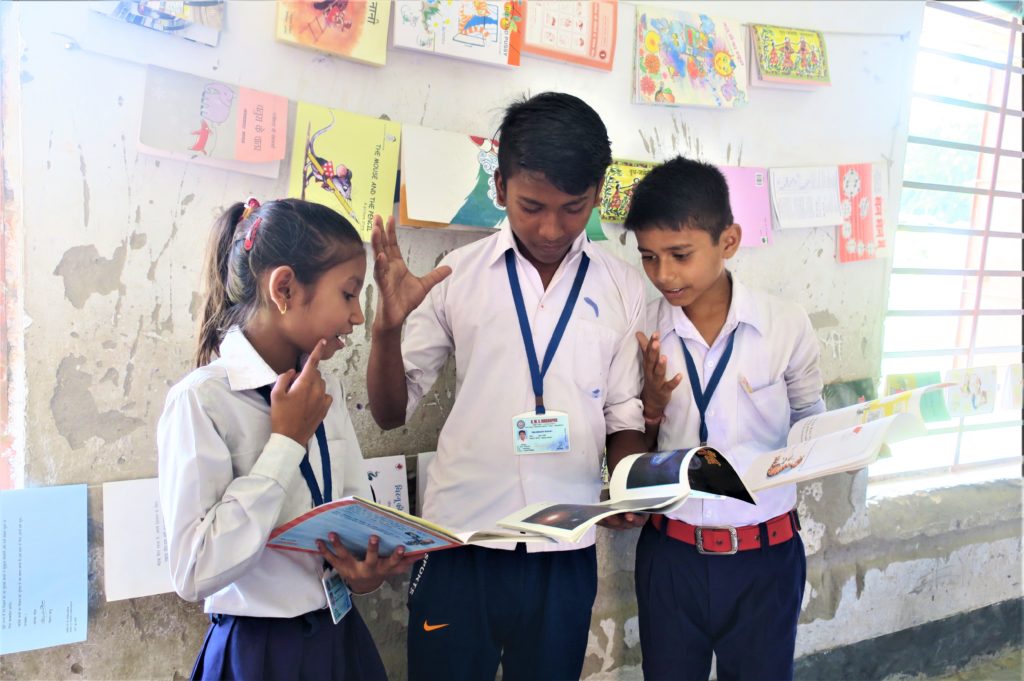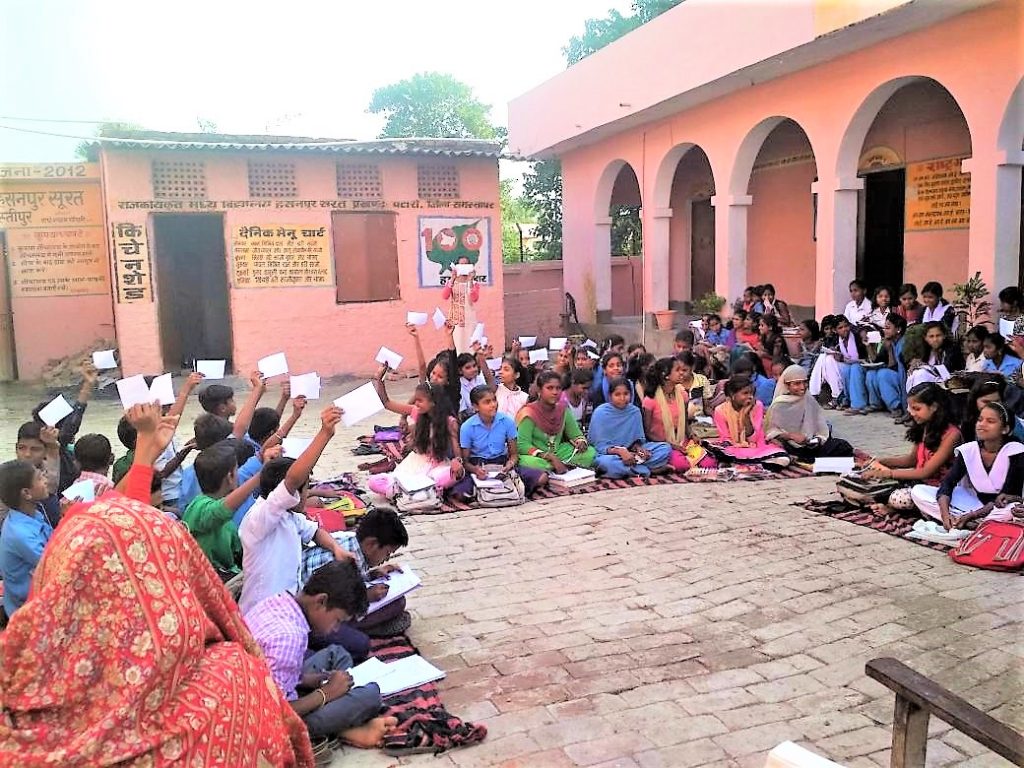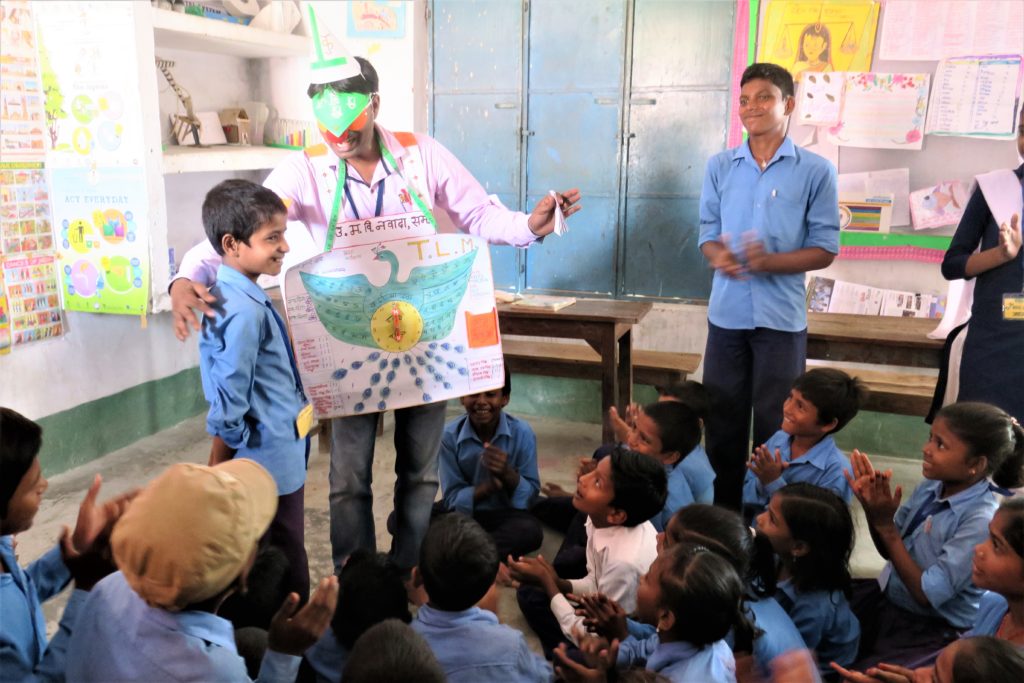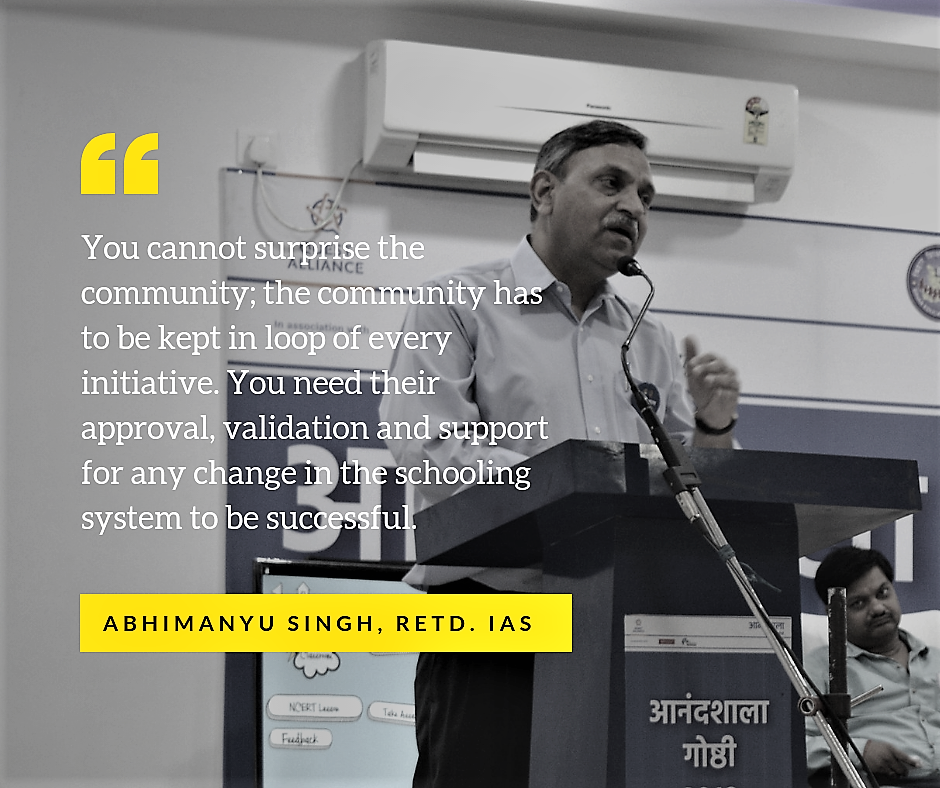Story
Anandshala Shiksha Ratn Puraskar
Exam scores aren’t the only measure of success in today’s schools. As a part of the Anandshala program, the Shiksha Ratn Puraskar is awarded to students, teachers and education functionaries who work exceptionally to drive change in their schools and enable quality education.
Details
Their successes and failures, big and small, offer food for thought for everybody who has a stake in the education system. Here's our series of stories of learning, change and pride shared at the #Anandshala Gosthi:
_________________________________________________________________
STUDENTS’ RETENTION
RUMS Madanpur, Samastipur
Old-fashioned maybe, but libraries continue to be these unassuming dynamic spaces where people come to access information, learn, build a community, build a life. This holds true for a school library as well.
The Madanpur Middle school of Samastipur took this up to keep its students. Student attendance would deteriorate through the day to 50% post the mid-day meal. But the key was to garner active involvement of parents. The parents limited their involvement with the school to parents-teachers meetings only. Headmaster, Mr. Pradeep, bolstered the student elected bodies, Bal Sansad and Meena Manch, to get students to participate more and have fun learning. He also believed more reading created better learners, and providing students books that interested them is another way to encourage students to read more. As an amalgamation of their intentions, objectives and capacities, a library seemed like the school’s best option.

They didn’t have one, so they got a room within the premises. They collated existing text books in the school, and reached out to the community since they needed more books for the library. Parents were asked to contribute one or two books for the school library. Parents could contribute their old books. It wasn’t compulsory to contribute though; it was good enough even if the parents turned up to the school.
With a slow but positive response from the community, books steadily poured into the school’s library. Students too found reads that interest them. The Bal Sansad took over the responsibility of maintaining records of withdrawals and submissions of books and scheduled library hours for every class. Students began staying back in school post the mid-day meal to read a book they liked. School attendance hiked to 85%. Reading books other than the textbooks was uncommon for students here, and this library facilitated interest-based reading.
_________________________________________________________________
STUDENTS’ RETENTION AND ENGAGEMENT
Hasanpur Surat Middle School, Patori
“We stopped believing that students would stay after the lunch break”,
say teachers at the Hasanpur Surat Middle School.
On the brink of losing the students’ interest in school activities and increasing the probability of dropouts, this middle school tried various class activities to connect with its students. Energetic, fidgety children left school before time and wandered off to play. Teachers narrowed options down to sports activities, and negotiated with students to play in the last hours. The logic was simple -- if students do not consider an activity worthy of their time and effort, they might not engage in a satisfactory way, and not learn anything.
“We thought that if students are leaving school early to play after lunch hours, then why don’t we have the sports period after lunch.” This was the turning point.

The school arranged indoor games equipment such as carrom board, badminton etc. for students. Last classes were assigned with sports, art and craft. Students took it up well and painted the classroom walls, adding color to the school. They now feel proud about their school and found a refreshing place to play and learn. Now most students stay back till the last class.
Channeling the energy to extra-curricular activities has also doubled engagement and sense of initiative. Teachers have adopted various play methods to teach concepts. Students read the news at the morning assembly. They also share a poem, essay or a story at the morning assembly. The loudspeaker used at morning assembly carries this to the village, allowing the community to witness this everyday. As next steps, the teachers hope to engage parents and the community, and activate Bal Sansad and Meena Manch.
_________________________________________________________________
RAPPORT BUILDING WITH THE COMMUNITY
Jagdev Middle School, Adharpur
Water is a basic necessity of life, but millions of people in India live in water-stressed areas. The Adharpur village situated in the uplands of Bihar has a chronic low water levels problem. Water retention policies were not successful for years, and the community struggled with scarce drinking water and water for sanitation. Despite limp, life went on here, until their school headmaster stepped up to solve one problem and ended up solving much more.
Pramod Thakur joined the Jagdev middle-school as the headmaster in 2016. Classrooms were half empty, no-water was a common feature, toilets were filthy and unusable. The community complained about the bad sanitation crisis, and refused to let their children attend school, especially adolescent girls. Young girls stayed at home for a week every month, or dropped out of school. Stuck with regular water crisis at their households, school issues weren’t a priority for the community.
Headmaster Thakur approached the School Management Committee to seek a solution to this problem that was increasingly affecting the health and hygiene of students and families. They figured since the problem was faced both by the school and community, a joint solution to the problem would also improve the rapport between community and school over time.
Teachers held a community meeting to talk about the issue. They sought support from Rajkumari Devi, the village Panchayat head. In the meeting it was decided to set up an overhead water tank and pipeline system for the school and community. The tap was set outside the school boundary and was available for the community to fulfill their water needs through the day and night. A common switch for the motor pumping water, even while the school was closed, was installed. The call for contribution in terms of manpower, decision making and financial aid from the community, made them more contributive and accountable, towards this newly installed water system at the school.

Community ownership of water and sanitation facilities of the school came about steadily. Parents attended school meetings and ensured that children were not absent from the school. Attendance improved progressively, performance improved successively. Adequate sanitation facilities for women and girls to manage menstruation, ensured that young women from the village continued their schooling.
Teachers now concentrate on other activities like activating the Bal Sansad and Meena Manch, to lead extra-curricular activities.
“We have to work towards sustaining the healthy relationship between the school and community, because someday we will not be here, but the community will be there and their support will help in identifying and resolving the school issues”, says a proud Pramod Thakur, headmaster.
_________________________________________________________________
STUDENTS’ RETENTION AND ENGAGEMENT
Nawada Middle School, Samastipur
“Earlier, we had to lock the main gate of the school, now the children love to stay till the last class”,
says Kumari Neetu, the school teacher, while explaining what practice they adopted to further the mission of reducing Bihar's dropout rate by meeting the needs of students in at-risk situations. This is the journey of Nawada Government Upgraded Middle School of Samastipur who became the change they wanted to see.
The story begins when students used to bunk classes after the mid day meal, to play in open spaces outside school premises. It doesn’t sound too serious until you learn that for every 10 children who are enrolled at the school only 5 attend full school hours. The average attendance rate of the school on any given day was 40-50%, and the dropout tendency proportionate to this.
The students found playing outside school more fascinating than studies and hence would make excuses to skip classes after lunch. Their interest to attend classes reduced over time, hampering their term scores. The teacher-student struggle got worse with each passing week. Gaps in their attendance accentuated gaps in their learning. Subjects seemed tougher, making students avoid them and eventually drop out.
Teachers realized that they are missing something that’s making students feel detached from school. Multiple discussions amongst teachers, headmasters to improve classroom instruction, offered little in way of solution so teachers sought ideas from students. Students were fairly articulate about their disinterest in reading books and sitting in the classroom for most of the day.
To step up to this issue, teachers and the headmaster focused on the last class of the day. The last class is a free class generally allocated for remedial teaching or revision. The Nawada Middle School teachers decided to use this last class for drama and cultural activities with students. These activities were linked to topics and concepts in their subjects. Drama, role play and songs excited students. Teachers were equally excited about these. “Sometime I used to dress, act like an animal or an object and the children used to laugh a lot”, says Vikas Gupta, a teacher here. He learnt of these interesting methods at an Anandshala block level meeting in 2016, and was glad to have been able to effectively use them in his school. He now speaks of this at other school meetings.

Through different role plays, students got an opportunity to expand their problem solving skills both verbally and non-verbally, making room for a sense of creativity. On the occasion of Children’s Day, an activity room was inaugurated and called it the Punarbalan Kakshya, which translates Reinforcement Room, the word implying positive reinforcement.
The last class enabled students to establish a space where they could explore their ideas, enquire on social issues and work in groups to question, respond, and explain what they think. This paved the way in icebreaking and developing a line of communication and friendship between teachers and students. Students were split into groups and given topics from their Hindi and English lessons to perform on. Amongst some of these stories and poems were also experiments from their science books.
Teachers also organized an exposure visit for the students of class VII and VIII at a nearby brick kiln to show the science experiment on temperature and energy. Conversations with the workers and employer at the kiln helped students understand health issues surrounding such work, and why workers wrap cloth around their head, nostrils and mouth to avoid inhaling dust.
Today the average attendance of the school on any given day is 60-70%.
Teachers continue to champion the cause for dropout prevention. They plan to make short videos of the role plays of stories and poems so that these videos can be used as digital resources for forthcoming batches of students. They’ve begun efforts to focus on student-led last class activities and strengthen community participation in the process.
Laxmi Devi, who once was the cook of the school is now the newly elected ward representative of the village. She has been a part of the school’s story for a long time and teachers are now looking forward for her support to boost improvement in the school as a member of School Management Committee. Now, if you visit the school, you are likely to be toured around by students who proudly show you their Punarbalan Kakshya and tell you about their experience there.
We hope to create a cadre of change leaders to cultivate and nurture effective methods for increasing student engagement and tech supported learning.
Abhimanyu Singh, Retd. IAS
Chairperson of Doosara Dashak